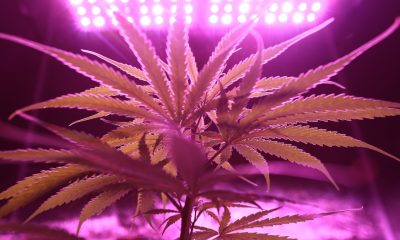Cannabis
Does Early Cannabis Use Put Youth at Risk for Addiction – Latest Research
Cannabis use among youth is rising globally, driven by increased legalization. Early use, before age 16, disrupts brain development, impairing memory, decision-making, and reward processing. It significantly raises the risk of cannabis use disorder (CUD) and problems with alcohol and nicotine. Adolescents are especially vulnerable due to peer influence and incomplete brain maturation.

In recent years, cannabis use has increased. Cannabis has become one of the most commonly used psychoactive substances among young people. According to a UN report (2023), between 3% and 17% of 15-16 year olds worldwide admit to using it regularly. The legalization of cannabis in many countries, such as Canada and some US states, has significantly increased its availability, which further contributes to the increase in the number of young users.
Adolescence is a crucial time for brain development. Early cannabis use can disrupt neurobiological processes, affecting the ability to concentrate, memory, and decision-making. What’s more, research suggests that early cannabis initiation increases the risk of developing cannabis use disorder (CUD) and problems with other substances, such as alcohol and nicotine.
Global data shows that cannabis use among youth is on the rise
In Europe, around 10% of high school students report having tried cannabis at least once in the past year (EMCDDA, 2024). In the US, the figure is around 15%, with use being higher in states where cannabis has been legalized. In Canada, cannabis use among under-18s has increased by 2 percentage points since legalization in 2018 (StatCan, 2023).
In research studies, early cannabis use is defined as initiation before the age of 14 or 16, depending on the context of the study. For example, in the analysis conducted by Swift et al. (2008), early use was defined as initiation before the age of 16. This age cut-off is due to the crucial importance of this period for the maturation of brain structures such as the prefrontal cortex.
Adolescence is a time of intense brain change, especially in the reward system and in areas responsible for memory and decision-making.
Early cannabis use can disrupt these processes by:
Effects on the dopamine system : Regular use of cannabis at a young age can impair the ability to feel satisfaction from daily activities.
Memory and concentration problems : cannabis affects the hippocampus, which can lead to difficulties with learning and remembering.
Development of addictions : Early exposure to psychoactive substances increases susceptibility to their abuse in adulthood.
Marijuana and Marijuana-Related Disorders (MIRACLES)
Early cannabis use is one of the most important risk factors for developing cannabis use disorder (CUD). Studies (Behrendt et al., 2009; Swift et al., 2008) indicate that individuals who began using cannabis before the age of 16 have a three times higher risk of developing CUD compared to those who began later.
Interestingly, the risk of developing CUD remains significant even after taking into account frequency of use. This indicates that the age of first cannabis use is an independent risk factor. For example, in the study by Behrendt et al. (2012), individuals with early initiation showed a higher risk of CUD, even if they used cannabis sporadically.
Cannabis use disorder may include:
Difficulty controlling frequency of use.
Problems in everyday life, e.g. at school or work.
Social withdrawal and substance focus.
Escalation of use despite negative consequences.
Adolescents are particularly susceptible to developing CUD due to:
Incomplete development of the prefrontal cortex , which is responsible for impulse control and decision-making.
Increased sensitivity to rewards , which makes psychoactive substances seem more attractive.
Strong peer influence , which increases the risk of early initiation and regular use.
The effects of early cannabis use on other substances
Alcohol
Research on the link between early cannabis use and alcohol problems has produced mixed results.
Taylor et al. (2017) found that individuals who began using cannabis before age 13 were more likely to develop alcohol problems in adulthood, a risk that decreased when accounting for frequency of alcohol use at a young age.
Kandel and Chen (2000) found that heavy cannabis use (regardless of age of initiation) increased the risk of alcoholism. The results suggest that frequency of use may play a greater role than age of first cannabis use.
Synergistic effect: cannabis and alcohol are often used together, which can increase the risk of addiction and negative health effects, such as memory problems, learning difficulties or road accidents.
Nicotine
Early cannabis use is also associated with a greater risk of nicotine addiction.
Taylor et al. (2017) found that individuals who started using cannabis before the age of 15 and used it regularly were more likely to develop nicotine dependence than those who started later.
Mixing cannabis with tobacco , e.g. in the form of joints , further increases the risk of nicotine addiction. According to research (Becker et al., 2015), such practices may be the first step to daily cigarette smoking.
Early cannabis use, especially before the age of 16, significantly increases the risk of developing a cannabis use disorder (CUD). Studies confirm that the age of initiation is an independent risk factor that can lead to problems with alcohol, nicotine, and in some cases, other substances. Moreover, early cannabis initiation negatively affects the cognitive development of adolescents and increases the risk of social problems, such as family conflicts, difficulties in education, and social withdrawal.
__
(Featured image by Pavel Danilyuk via Pexels)
DISCLAIMER: This article was written by a third party contributor and does not reflect the opinion of Born2Invest, its management, staff or its associates. Please review our disclaimer for more information.
This article may include forward-looking statements. These forward-looking statements generally are identified by the words “believe,” “project,” “estimate,” “become,” “plan,” “will,” and similar expressions. These forward-looking statements involve known and unknown risks as well as uncertainties, including those discussed in the following cautionary statements and elsewhere in this article and on this site. Although the Company may believe that its expectations are based on reasonable assumptions, the actual results that the Company may achieve may differ materially from any forward-looking statements, which reflect the opinions of the management of the Company only as of the date hereof. Additionally, please make sure to read these important disclosures.
First published in Fakty Konopne. A third-party contributor translated and adapted the article from the original. In case of discrepancy, the original will prevail.
Although we made reasonable efforts to provide accurate translations, some parts may be incorrect. Born2Invest assumes no responsibility for errors, omissions or ambiguities in the translations provided on this website. Any person or entity relying on translated content does so at their own risk. Born2Invest is not responsible for losses caused by such reliance on the accuracy or reliability of translated information. If you wish to report an error or inaccuracy in the translation, we encourage you to contact us

-

 Crypto2 weeks ago
Crypto2 weeks agoCrypto Markets Slide as Bitcoin Breaks $90K, Year-End Pessimism Grows
-

 Impact Investing1 week ago
Impact Investing1 week agoTreeblock Showcases Sustainability Solutions at ADIPEC Abu Dhabi
-

 Cannabis2 weeks ago
Cannabis2 weeks agoRemexian Wins Legal Battles Amid German Cannabis Licensing Dispute
-

 Impact Investing4 days ago
Impact Investing4 days agoHigh Awareness, Low Adoption: The VSME Challenge for European SMEs

























